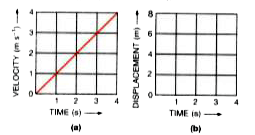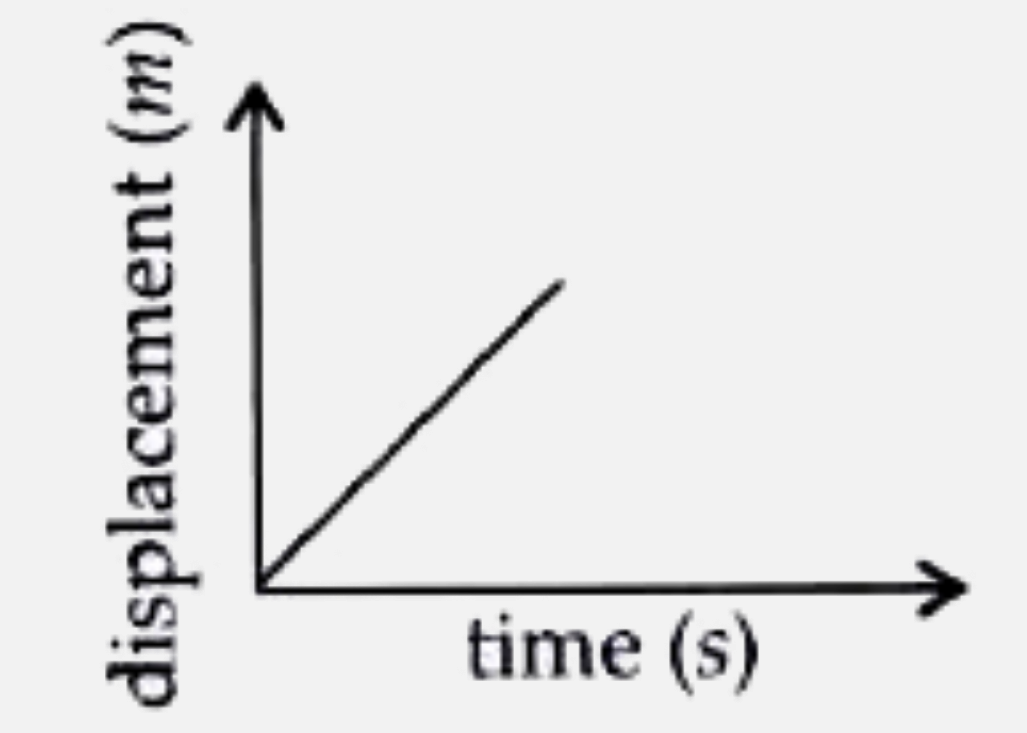What informations about the motion of a body are obtained from the displacement-time graph ?
To answer the question about the information obtained from a displacement-time graph, we can break down the solution into clear steps:
1. Understanding the Graph:
- A displacement-time graph plots displacement (y-axis) against time (x-axis). The shape and slope of the graph provide insights into the motion of the body.
2. Nature of Motion:
- From the graph, we can determine whether the body is at rest or in motion.
- If the displacement remains constant as time increases (a horizontal line), the body is at rest.
- If the displacement changes with time (a sloped line), the body is in motion.
3. Determining Velocity:
- The slope of the displacement-time graph represents the velocity of the body.
- Mathematically, velocity (v) can be defined as the change in displacement (Δs) over the change in time (Δt), which is the slope (tan θ) of the graph.
- A steeper slope indicates a higher velocity, while a horizontal line indicates zero velocity.
4. Creating a Velocity-Time Graph:
- From the displacement-time graph, we can derive a velocity-time graph.
- By calculating the slope at various points on the displacement-time graph, we can plot these values on a new graph to visualize how velocity changes over time.
Summary of Information from Displacement-Time Graph:
- Nature of Motion: Indicates whether the body is at rest or in motion.
- Velocity: The slope of the graph gives the velocity of the body.
- Velocity-Time Graph: Allows us to create a velocity-time graph based on the slopes at different points.
- A displacement-time graph plots displacement (y-axis) against time (x-axis). The shape and slope of the graph provide insights into the motion of the body.
- From the graph, we can determine whether the body is at rest or in motion.
- If the displacement remains constant as time increases (a horizontal line), the body is at rest.
- If the displacement changes with time (a sloped line), the body is in motion.
- The slope of the displacement-time graph represents the velocity of the body.
- Mathematically, velocity (v) can be defined as the change in displacement (Δs) over the change in time (Δt), which is the slope (tan θ) of the graph.
- A steeper slope indicates a higher velocity, while a horizontal line indicates zero velocity.
- From the displacement-time graph, we can derive a velocity-time graph.
- By calculating the slope at various points on the displacement-time graph, we can plot these values on a new graph to visualize how velocity changes over time.
- Nature of Motion: Indicates whether the body is at rest or in motion.
- Velocity: The slope of the graph gives the velocity of the body.
- Velocity-Time Graph: Allows us to create a velocity-time graph based on the slopes at different points.
Topper's Solved these Questions
- MOTION IN ONE DIMENSION BOOK - ICSECHAPTER - MOTION IN ONE DIMENSION EXERCISE - EXERCISE -2 (B) ( Multiple choice type :)
3 Videos
- MOTION IN ONE DIMENSION BOOK - ICSECHAPTER - MOTION IN ONE DIMENSION EXERCISE - EXERCISE -2 (B) ( Numericals )
12 Videos
- MOTION IN ONE DIMENSION BOOK - ICSECHAPTER - MOTION IN ONE DIMENSION EXERCISE - EXERCISE -2 (A) ( Numericals )
16 Videos
- MEASUREMENTS AND EXPERIMENTATION BOOK - ICSECHAPTER - MEASUREMENTS AND EXPERIMENTATION EXERCISE - TOPIC 2 SIMPLE PENDULUM (4 Marks Questions )
1 Videos
- PRESSURE IN FLUIDS AND ATMOSPHERIC PRESSUREBOOK - ICSECHAPTER - PRESSURE IN FLUIDS AND ATMOSPHERIC PRESSUREEXERCISE - Exercise -4(B)Numericals
5 Videos
Similar Questions
What can you say about the nature of motion of a body if its displacement-time graph is
(a) a straight line parallel to time axis ?
(b) a straight line inclined to the time axis with an acute angle?
(c) a straight line inclined to the time axis with an obtuse angle ?
(d) a curve.
View SolutionWhat does the slope of a displacement-time graph represent?
View Solution
Knowledge Check
For a uniformly retarded motion, the velocity-time graph is :
Aa curveBa straight line parallel to the time axisCa straight line perpendicular to the time axis.Da straight line inclined to the time axis.
What can you say about the motion of an object whose distance-time graph is a straight line parallel to the time axis ?
View SolutionWhat can you say about the motion of an object whose distance-time graph is a straight line parallel to the time axis ?
View SolutionFig. 2.41 (a) shows the velocity-time graph for the motion of a body. Use it to find the displacement of the body at t = 1 s, 2 s, 3 s and 4 s, then draw the displacement-time graph for it on Fig. 2.41 (b).

View SolutionThe motion of a body is represented by the following displacement-time graph.

How can the velocity of the body be determined from the above graph?
View SolutionThe motion of a body is represented by the following displacement-time graph.

State the type of motion represented in the graph.
View SolutionWhat is obtained from the body of insects?
View SolutionA body at rest is made to fall from the top of a tower. Its displacement at different instants is given in the following table : Draw a displacement-time graph and state whether the motion is uniform or non-uniform?

View Solution
